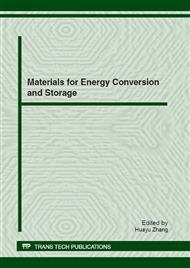[1]
Y.T. Zhong, X. Wang, K. C. Jiang, et al., A facile synthesis and lithium storage properties of Co3O4-C hybrid core-shell and hollow spheres, J. Mater. Chem. 21 (2011) 17998-18002.
DOI: 10.1039/c1jm12765a
Google Scholar
[2]
Y.Q. Zou, J. Kan, Y. Wang, Fe2O3-graphene rice-on-sheet nanocomposite for high and fast lithium ion storage, J. Phys. Chem. C 115 (2011) 20747-20753.
DOI: 10.1021/jp206876t
Google Scholar
[3]
Z. M. Cui, L.Y. Jiang, W. G. Song, et al., High-yield gas-liquid interfacial synthesis of highly dispersed Fe3O4 nanocrystals and their application in lithium-ion batteries, Chem. Mater. 21 (2009) 1162-1166.
DOI: 10.1021/cm8033609
Google Scholar
[4]
T. Yoon, C.J. Chae, Y.K. Sun, et al., Bottom-up in situ formation of Fe3O4 nanocrystals in a porous carbon foam for lithium-ion battery anodes, J. Mater. Chem. 21 (2011) 17325-17330.
DOI: 10.1039/c1jm13450g
Google Scholar
[5]
P.C. Lian, X.F. Zhu, H.F. Xiang, et al., Enhanced cycling performance of Fe3O4-graphene nanocomposite as an anode material for lithium-ion batteries. Electrochim. Acta. 56 (2010) 834-840.
DOI: 10.1016/j.electacta.2010.09.086
Google Scholar
[6]
G.M. Zhou, D. W. Wang, F. Li, et al., Graphene-wrapped Fe3O4 anode material with improved reversible capacity and cyclic stability for lithium ion batteries, Chem. Mater. 22 (2010) 5306-5313.
DOI: 10.1021/cm101532x
Google Scholar
[7]
D.Y. Chen, G. Ji, Y. Ma, J.Y. Lee, J.M. Lu, Graphene-encapsulated hollow Fe3O4 nanoparticle aggregates as a high-performance anode material for lithium ion batteries, ACS Appl. Mater. Interfaces. 3 (2011) 3078-3083.
DOI: 10.1021/am200592r
Google Scholar
[8]
W. S. Hummers,; R. E. Offeman, Preparation of graphitic oxide, J. Am. Chem. Soc. 80 (1958) 1339.
DOI: 10.1021/ja01539a017
Google Scholar
[9]
K.F. Zhou, Y.H. Zhu, X.L. Yang, One-pot preparation of graphene/Fe3O4 composites by a solvothermal reaction, New J. Chem. 34 (2010) 2950-2955.
DOI: 10.1039/c0nj00283f
Google Scholar
[10]
S.L. Chou, J.Z. Wang, D. Wexler, K. Konstantinov, C. Zhong, H.K. Liu, S.X. Dou, High-surface-area α-Fe2O3/carbon nanocomposite: one-step synthesis and its highly reversible and enhanced high-rate lithium storage properties, J. Mater. Chem. 20 (2010) 2092-2098.
DOI: 10.1039/b922237e
Google Scholar
[11]
P. Guo, H.H. Song , X.H. Chen, Electrochemical performance of graphene nanosheets as anode material for lithium-ion batteries, Electrochem. Commun. 11 (2009) 1320-1324.
DOI: 10.1016/j.elecom.2009.04.036
Google Scholar
[12]
J. Su, M.H. Cao, L. Ren, C.W. Hu, Fe3O4-graphene nanocomposites with improved lithium storage and magnetism properties, J. Phys. Chem. C 115 (2011) 14469-14477.
DOI: 10.1021/jp201666s
Google Scholar



